Evaluation of Properties and Microstructure of Cement Paste Blended with Metakaolin Subjected to High Temperatures
Abstract
:1. Introduction
2. Experimental
2.1. Materials
2.2. Specimen Preparation
2.3. Characterization Methods
2.3.1. Compressive Strength
2.3.2. Mercury Intrusion Porosimetry (MIP)
2.3.3. X-ray Diffraction (XRD)
2.3.4. Fourier Transform Infrared Spectroscopy (FTIR)
2.3.5. Scanning Electron Microscopy (SEM)
2.3.6. Shrinkage
2.3.7. Water Absorption
3. Results and Discussion
3.1. Compressive Strength and Appearance
3.2. Pore Structure
3.3. Microstructure
3.4. Shrinkage
3.5. Water Absorption
4. Conclusions
- (1)
- The compressive strength increases at 200 °C and 400 °C compared with that obtained at ambient temperature regardless of metakaolin addition. Up to 800 °C, the compressive strength decreases rapidly. The addition of 10% metakaolin causes an increase of about 15% on the compressive strength at ambient temperature and it enhances the compressive strength by about 20%, 24%, 14% and 15% at 200 °C, 400 °C, 600 °C and 800 °C, respectively. Compressive strength reaches the maximum value at 400 °C.
- (2)
- The porosity decreases with the addition of metakaolin regardless of exposure temperatures and the critical pore diameters, defined as the peaks in the differential curves, shift to low values with the addition of metakaolin at different target temperatures. The thermal exposure degrades the pore structure and metakaolin addition improves the refinement of pore structure.
- (3)
- The cement paste shows some cracks and a high ratio of porosity after 400 °C exposure. With the increasing target temperature to 800 °C, porous structure can be observed compared to the reference paste. Metakaolin addition results in much denser microstructure before and after elevated temperature exposure due to the pozzolanic reaction between metakaolin and hydration product CH, which leads to denser microstructure. Addition of 10% metakaolin presents good thermal resistance.
- (4)
- As the temperature increases, the C-S-H gel in the cement paste dehydrates and forms anhydrous calcium silicate at 600 °C. The bonding between the hydration products is severely damaged, resulting in a sharp drop in the compressive strength of the cement paste.
- (5)
- Polynomial equation can be used to reflect the shrinkage evolution in cement paste or metakaolin-blended cement paste with testing days. Cement exhibits higher shrinkage values compared to metakaolin-blended pastes regardless of the target temperature. After high temperature exposure, cement paste and metakaolin-blended paste all exhibit higher shrinkage compared to that at room temperature.
- (6)
- The metakaolin-blended specimen indicates less water absorption compared to neat cement paste regardless of exposure temperature. Water absorption is relatively higher after exposed to elevated temperatures.
Author Contributions
Funding
Conflicts of Interest
References
- Zhang, M.H.; Malhotra, V.M. Characteristics of a thermally activated alumino-silicate pozzolanic material and its use in concrete. Cem. Concr. Res. 1995, 25, 1713–1725. [Google Scholar] [CrossRef]
- Rashad, A.M. Metakaolin as cementitious material: History, scours, production and composition: A comprehensive overview. Constr. Build. Mater. 2013, 41, 303–318. [Google Scholar] [CrossRef]
- Sabir, B.B.; Wild, S.; Bai, J. Metakaolin and calcined clays as pozzolans for concrete: A review. Cem. Concr. Compos. 2001, 23, 441–454. [Google Scholar] [CrossRef]
- Kakali, G.; Perraki, T.; Tsivilis, S.; Badogiannis, E. Thermal treatment of kaolin: The effect of mineralogy on the pozzolanic activity. Appl. Clay Sci. 2001, 20, 73–80. [Google Scholar] [CrossRef]
- Kavitha, O.R.; Shanthi, V.M.; Arulraj, G.P.; Sivakumar, P. Fresh, micro- and macrolevel studies of metakaolin blended self-compacting concrete. Appl. Clay Sci. 2015, 114, 370–374. [Google Scholar] [CrossRef]
- Shvarzman, A.; Kovler, K.; Grader, G.S.; Shter, G.E. The effect of dehydroxylation/amorphization degree on pozzolanic activity of kaolinite. Cem. Concr. Res. 2003, 33, 405–416. [Google Scholar] [CrossRef]
- Shi, Z.G.; Lothenbach, B.; Geiker, M.R.; Kaufmann, J.; Leemann, A.; Ferreiro, S.; Skibsted, J. Experimental studies and thermodynamic modeling of the carbonation of Portland cement, metakaolin and limestone mortars. Cem. Concr. Res. 2016, 88, 60–72. [Google Scholar] [CrossRef]
- Lu, X.; Chen, B. Experimental study of magnesium phosphate cements modified by metakaolin. Constr. Build. Mater. 2016, 123, 719–726. [Google Scholar] [CrossRef]
- Gruber, K.A.; Ramlochan, T.; Boddy, A.; Hooton, R.; Thomas, M.D.A. Increasing concrete durability with high-reactivity metakaolin. Cem. Concr. Compos. 2001, 23, 479–484. [Google Scholar] [CrossRef]
- Poon, C.S.; Kou, S.C.; Lam, L. Compressive strength, chloride diffusivity and pore structure of high performance metakaolin and silica fume concrete. Constr. Build. Mater. 2006, 20, 858–865. [Google Scholar] [CrossRef]
- Duan, P.; Shui, Z.H.; Chen, W.; Shen, C.H. Efficiency of mineral admixtures in concrete: Microstructure, compressive strength and stability of hydrate phases. Appl. Clay Sci. 2013, 83, 115–121. [Google Scholar] [CrossRef]
- Shanahan, N.; Markandeya, A.; Elnihum, A.; Stetsko, Y.P.; Zayed, A. Multi-technique investigation of metakaolin and slag blended Portland cement pastes. Appl. Clay Sci. 2016, 132, 449–459. [Google Scholar] [CrossRef]
- Johari, M.A.M.; Brooks, J.J.; Kabir, S.; Rivard, P. Influence of supplementary cementitious materials on engineering properties of high strength concrete. Constr. Build. Mater. 2011, 25, 2639–2648. [Google Scholar] [CrossRef]
- Aslani, F.; Samali, B. Predicting the bond between concrete and reinforcing steel at elevated temperatures. Struct. Eng. Mech. 2013, 48, 643–660. [Google Scholar] [CrossRef]
- Khaliq, W.; Khan, H.A. High temperature material properties of calcium aluminate cement concrete. Constr. Build. Mater. 2015, 94, 475–487. [Google Scholar] [CrossRef]
- Maarup, C.; Hjuler, K.; Johansen, K.D. High temperature cement raw meal flowability. Powder Technol. 2014, 253, 686–690. [Google Scholar] [CrossRef]
- Donatello, S.; Kuenzel, C.; Palomo, A.; Jimenez, A.F. High temperature resistance of a very high volume fly ash cement paste. Cem. Concr. Compos. 2014, 45, 234–242. [Google Scholar] [CrossRef]
- Ergüna, A.; Kürklüa, G.; Serhatb, B.M.; Mansourc, M.Y. The effect of cement dosage on mechanical properties of concrete exposed to high temperatures. Fire Saf. J. 2013, 55, 160–167. [Google Scholar] [CrossRef]
- Soldatov, S.; Umminger, M.; Heinzel, A.; Link, G.; Lepers, B.; Jelonnek, J. Dielectric characterization of concrete at high temperatures. Cem. Concr. Compos. 2016, 73, 54–61. [Google Scholar] [CrossRef]
- Rashad, A.M.; Sadek, D.M. An investigation on Portland cement replaced by high-volume GGBS pastes modified with micro-sized of metakaolin subjected to elevated temperatures. Int. J. Sustain. Built Environ. 2017, 6, 91–101. [Google Scholar] [CrossRef]
- Bu, Y.H.; Du, J.P.; Guo, S.L.; Liu, H.J.; Huang, C.X. Properties of oil well cement with high dosage of metakaolin. Constr. Build. Mater. 2016, 112, 39–48. [Google Scholar] [CrossRef]
- Subasi, A.; Emiroglu, M. Effect of metakaolin substitution on physical, mechanical and hydration process of white Portland cement. Constr. Build. Mater. 2015, 95, 257–268. [Google Scholar] [CrossRef]
- Brooks, J.J.; Johari, M.A.; Mazloom, M. Effect of admixtures on setting times of high-strength concrete. Cem. Concr. Compos. 2000, 22, 293–301. [Google Scholar] [CrossRef]
- Tanyildizi, H.; Şahin, M. Application of Taguchi method for optimization of concrete strengthened with polymer after high temperature. Constr. Build. Mater. 2015, 79, 97–103. [Google Scholar] [CrossRef]
- Tafraoui, A.; Escadeillas, G.; Vidal, T. Durability of the ultra high performances concrete containing metakaolin. Constr. Build. Mater. 2016, 112, 980–987. [Google Scholar] [CrossRef]
- Duan, P.; Shui, Z.H.; Chen, W.; Shen, C.H. Effects of metakaolin, silica fume and slag on pore structure, interfacial transition zone and compressive strength of concrete. Constr. Build. Mater. 2013, 44, 1–6. [Google Scholar] [CrossRef]
- Norhasri, M.S.M.; Hamidah, M.S.; Fadzil, A.M.; Megawati, O. Inclusion of nano metakaolin as additive in ultra high performance concrete (UHPC). Constr. Build. Mater. 2016, 127, 167–175. [Google Scholar] [CrossRef]
- Zhang, Z.H.; Wang, H.; Zhu, Y.C.; Reid, A.; Provis, J.L.; Bullen, F. Using fly ash to partially substitute metakaolin in geopolymer synthesis. Appl. Clay Sci. 2014, 88, 194–201. [Google Scholar] [CrossRef]
- Carmonaquiroga, P.M. Blancovarela, M.T. Ettringite decomposition in the presence of barium carbonate. Cem. Concr. Res. 2013, 52, 140–148. [Google Scholar] [CrossRef]
- He, Z.; Liang, W.; Wang, L.; Wang, J. Synthesis of C3S by sol-gel technique and its features. J. Wuhan Univ. Technol. Mater. Sci. Ed. 2010, 25, 138–141. [Google Scholar] [CrossRef]
- Silva, D.A.; Roman, H.R.; Gleize, P.J.P. Evidences of chemical interaction between EVA and hydrating Portland cement. Cem. Concr. Res. 2002, 32, 1383–1390. [Google Scholar] [CrossRef]
- Chindaprasirt, P.; Paisitsrisawat, P.; Rattanasak, U. Strength and resistance to sulfate and sulfuric acid of ground fluidized bed combustion fly ash-silica fume alkali-activated composite. Adv. Powder Technol. 2014, 25, 1087–1093. [Google Scholar] [CrossRef]
- Zhang, T.; Shang, S.; Yin, F.; Aishah, A.; Salmiah, A.; Ooi, T.L. Adsorptive behavior of surfactants on surface of Portland cement. Cem. Concr. Res. 2001, 31, 1009–1015. [Google Scholar] [CrossRef]
- Wei, Y.Q.; Yao, W.; Xing, X.M.; Wu, M.J. Quantitative evaluation of hydrated cement modified by silica fume using QXRD, 27Al MAS NMR, TG-DSC and selective dissolution techniques. Constr. Build. Mater. 2012, 36, 925–932. [Google Scholar] [CrossRef]
- Collins, F.G.; Sanjayan, J.G. Effect of pore size distribution on drying shrinkage of alkali-activated slag concrete. Cem. Concr. Res. 2000, 30, 1401–1406. [Google Scholar] [CrossRef]
- Jiang, Z.; Sun, Z.; Wang, P. Autogenous relative humidity change an autogenous shrinkage of high-performance cement pastes. Cem. Concr. Res. 2005, 35, 1539–1545. [Google Scholar] [CrossRef]
- Gleize, P.J.P.; Cyr, M.; Escadeillas, G. Effects of metakaolin on autogenous shrinkage of cement pastes. Cem. Concr. Compos. 2007, 29, 80–87. [Google Scholar] [CrossRef]
- Güneyisi, E.; Gesoğlu, M.; Mermerdaş, K. Improving strength, drying shrinkage, and pore structure of concrete using metakaolin. Mater. Struct. 2008, 41, 937–949. [Google Scholar] [CrossRef]
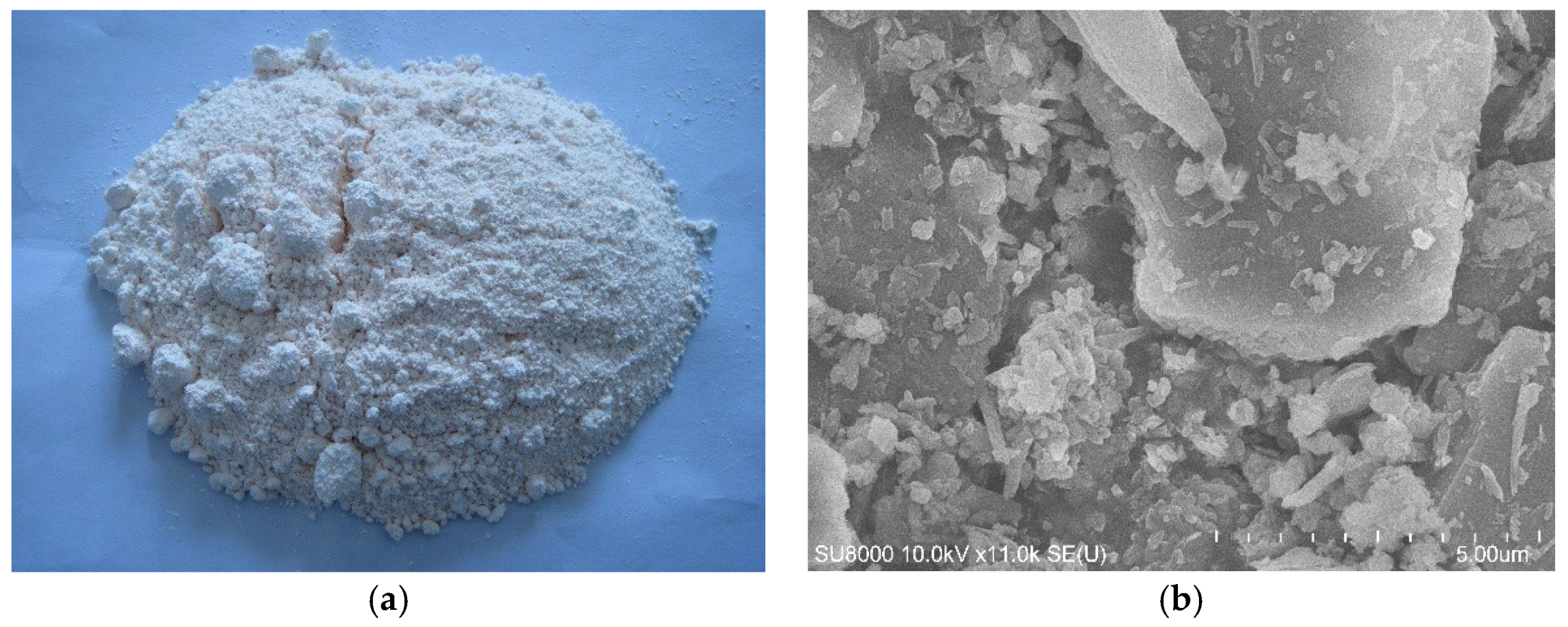

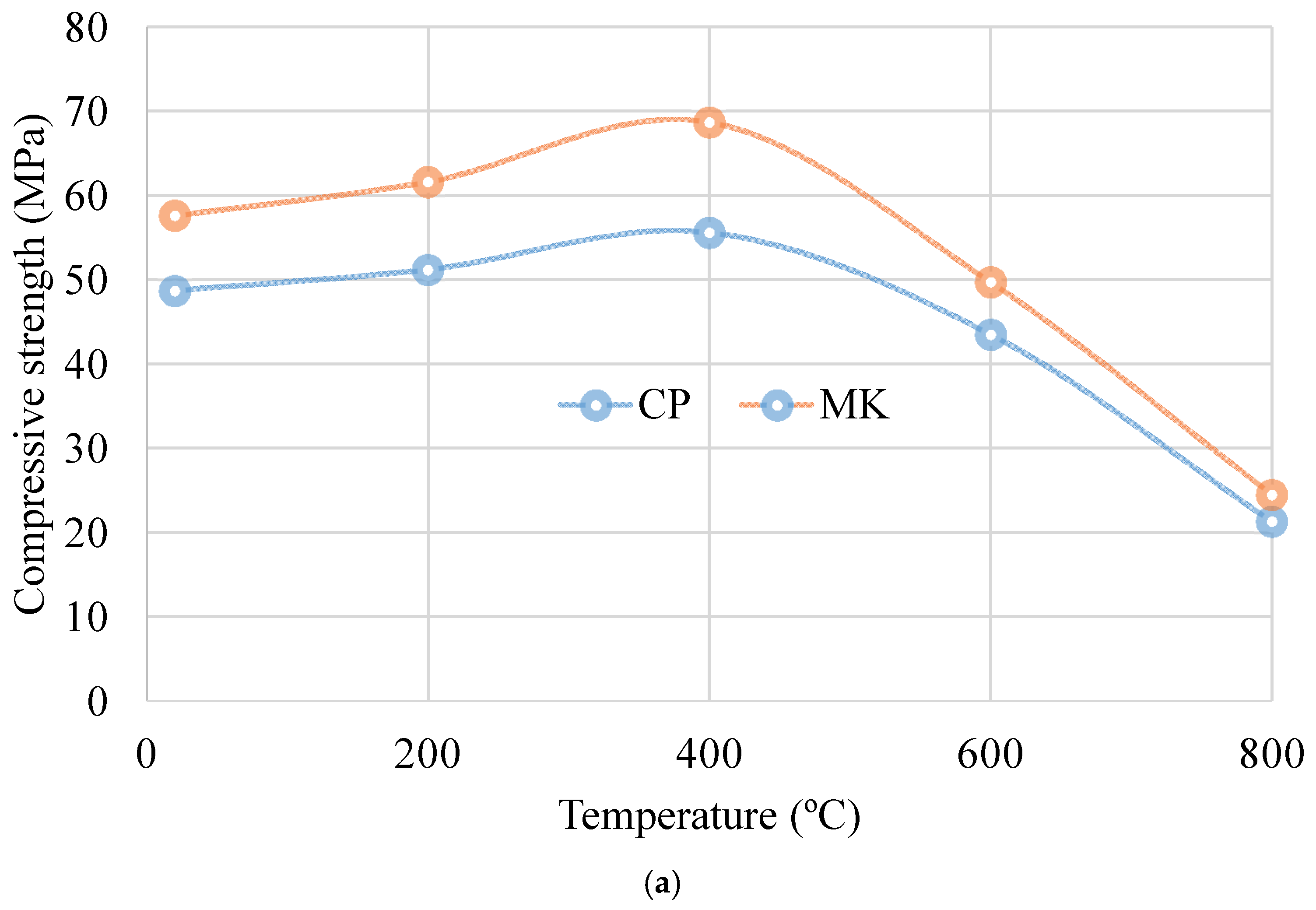
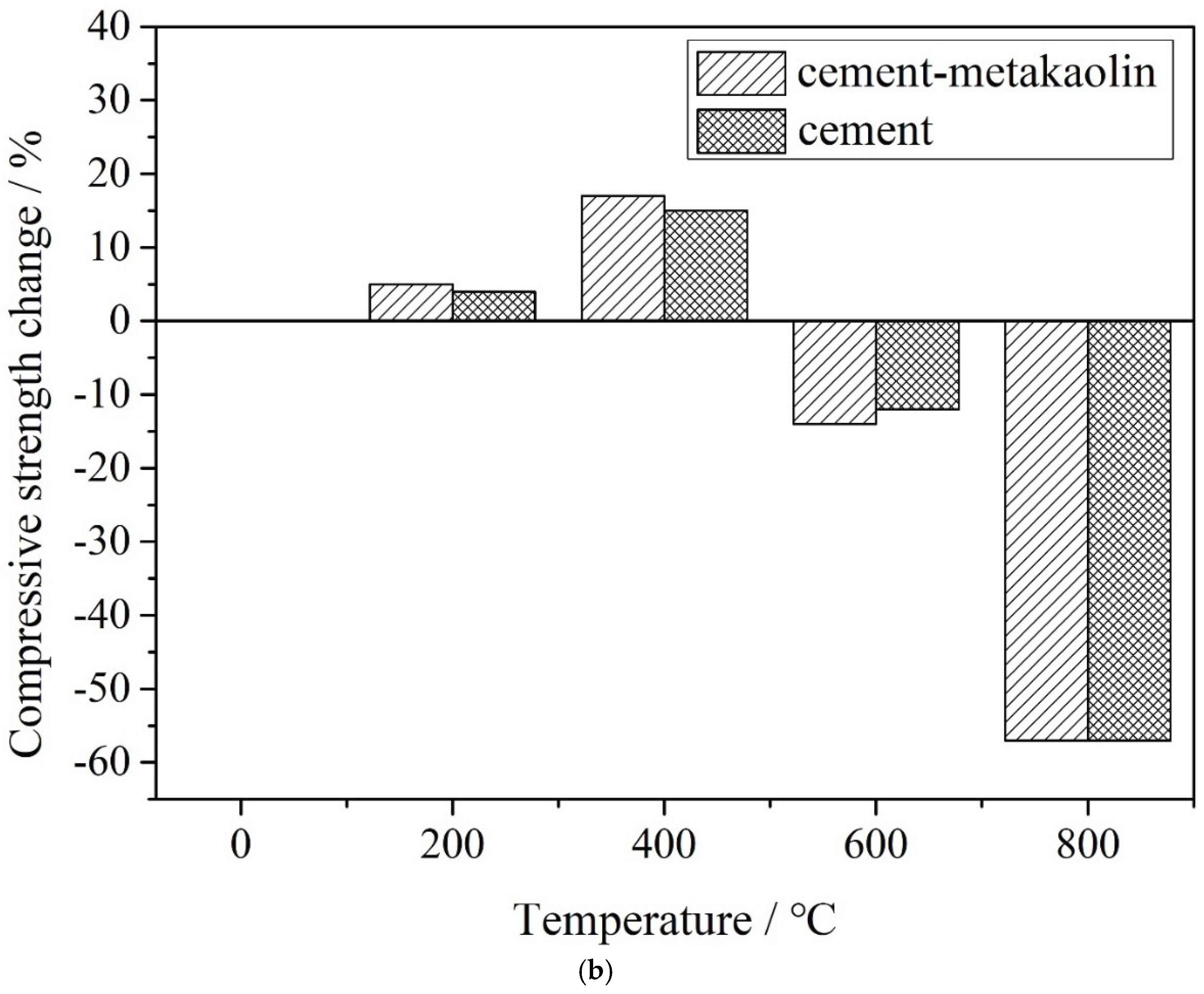
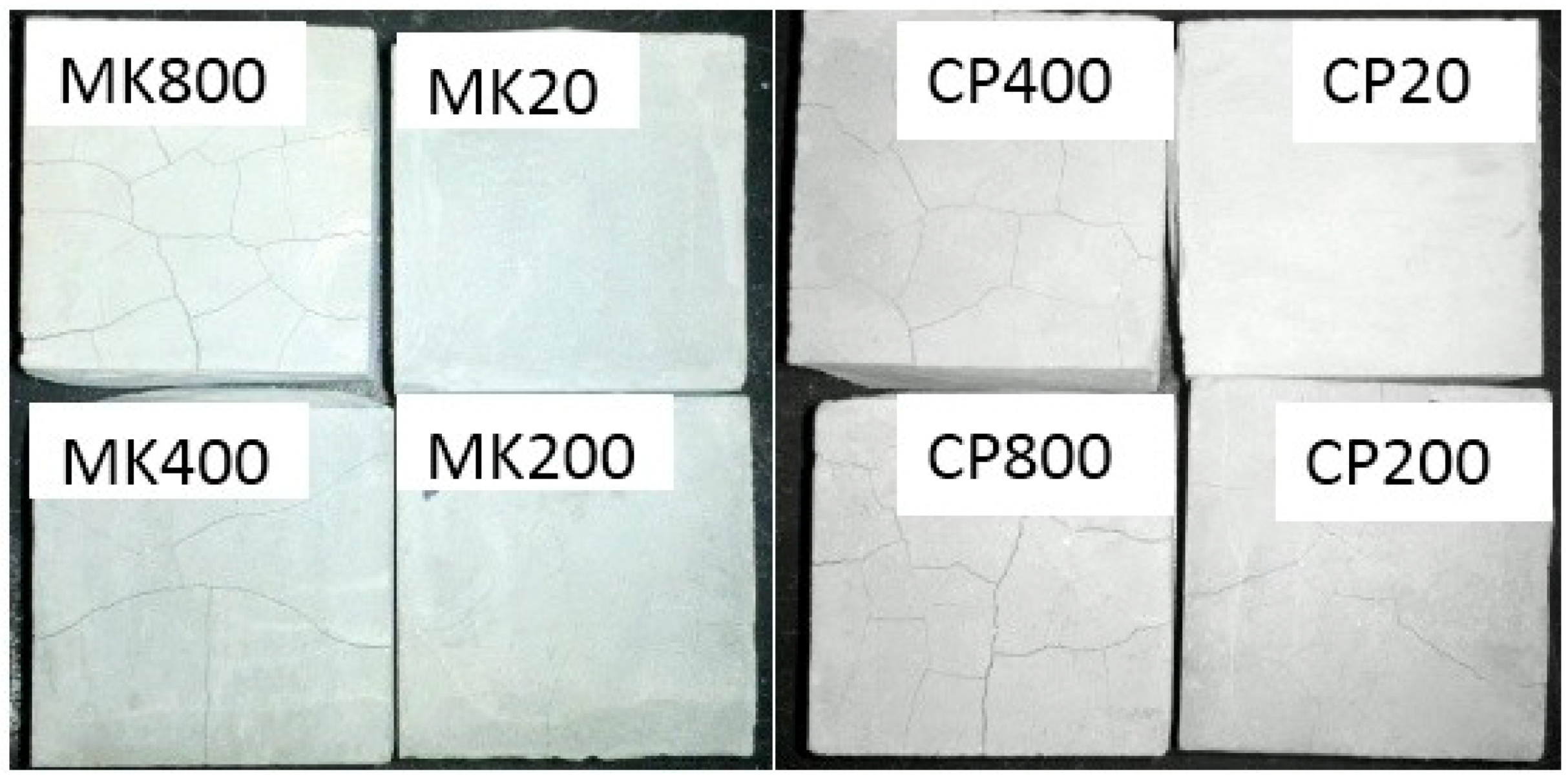
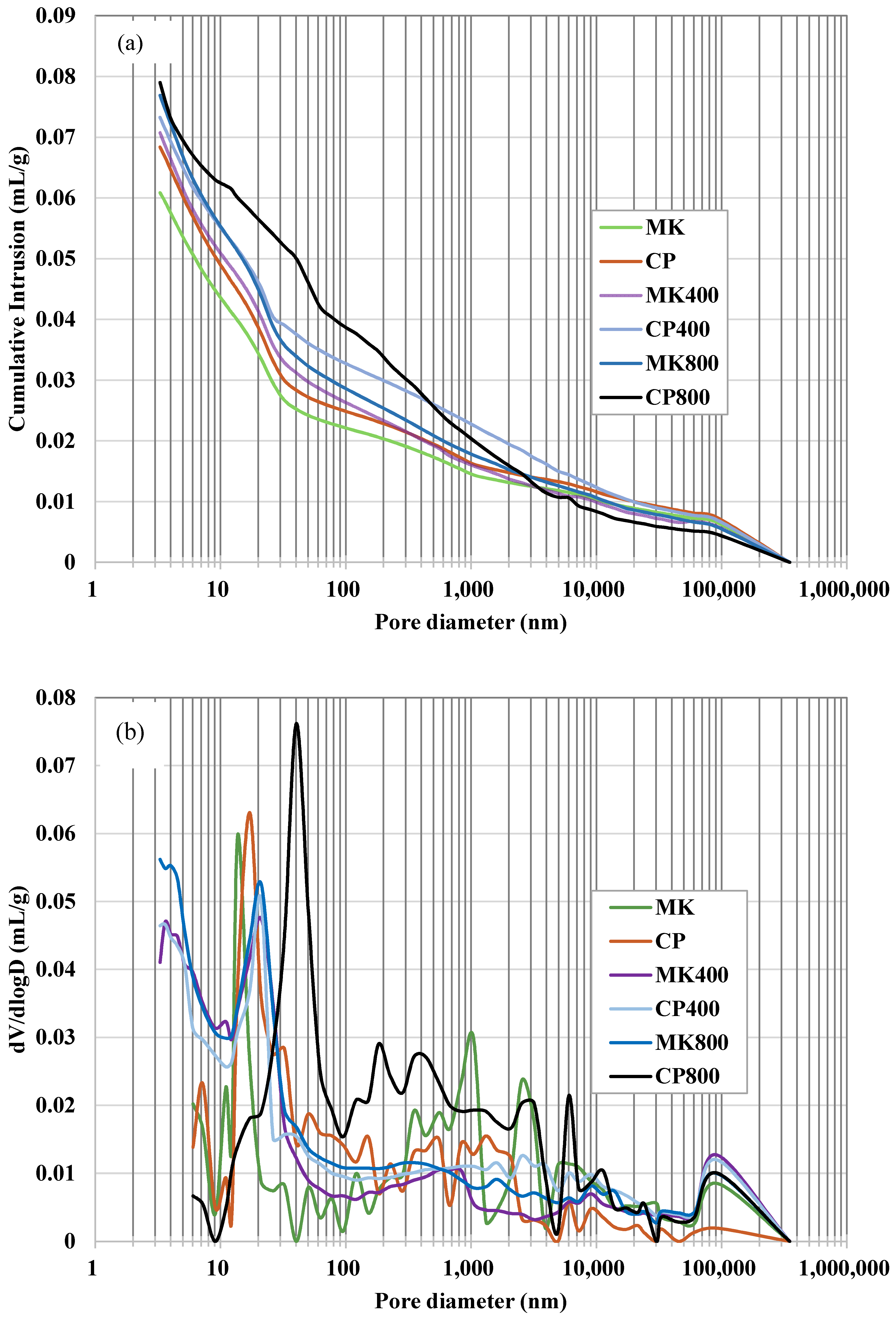
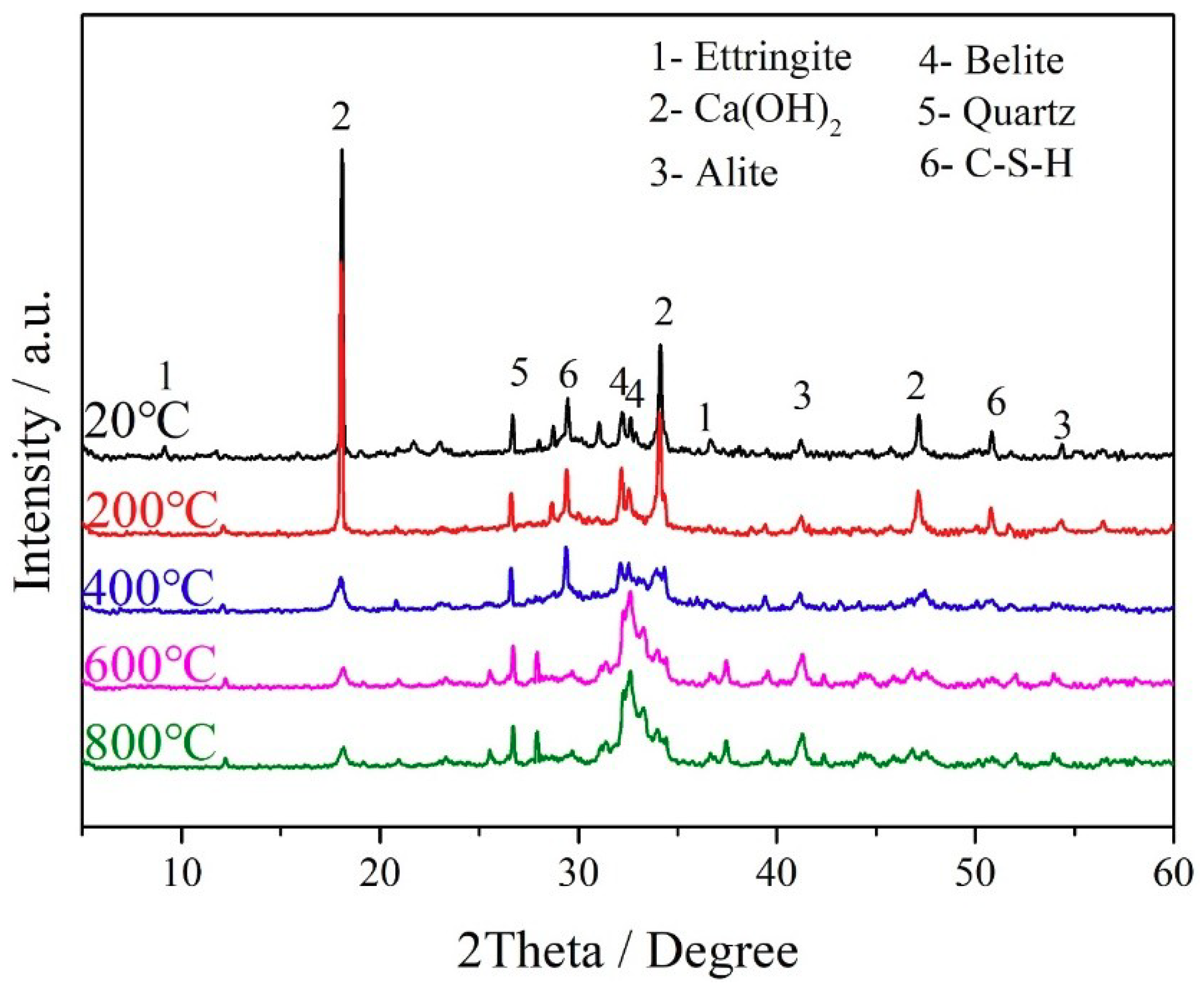

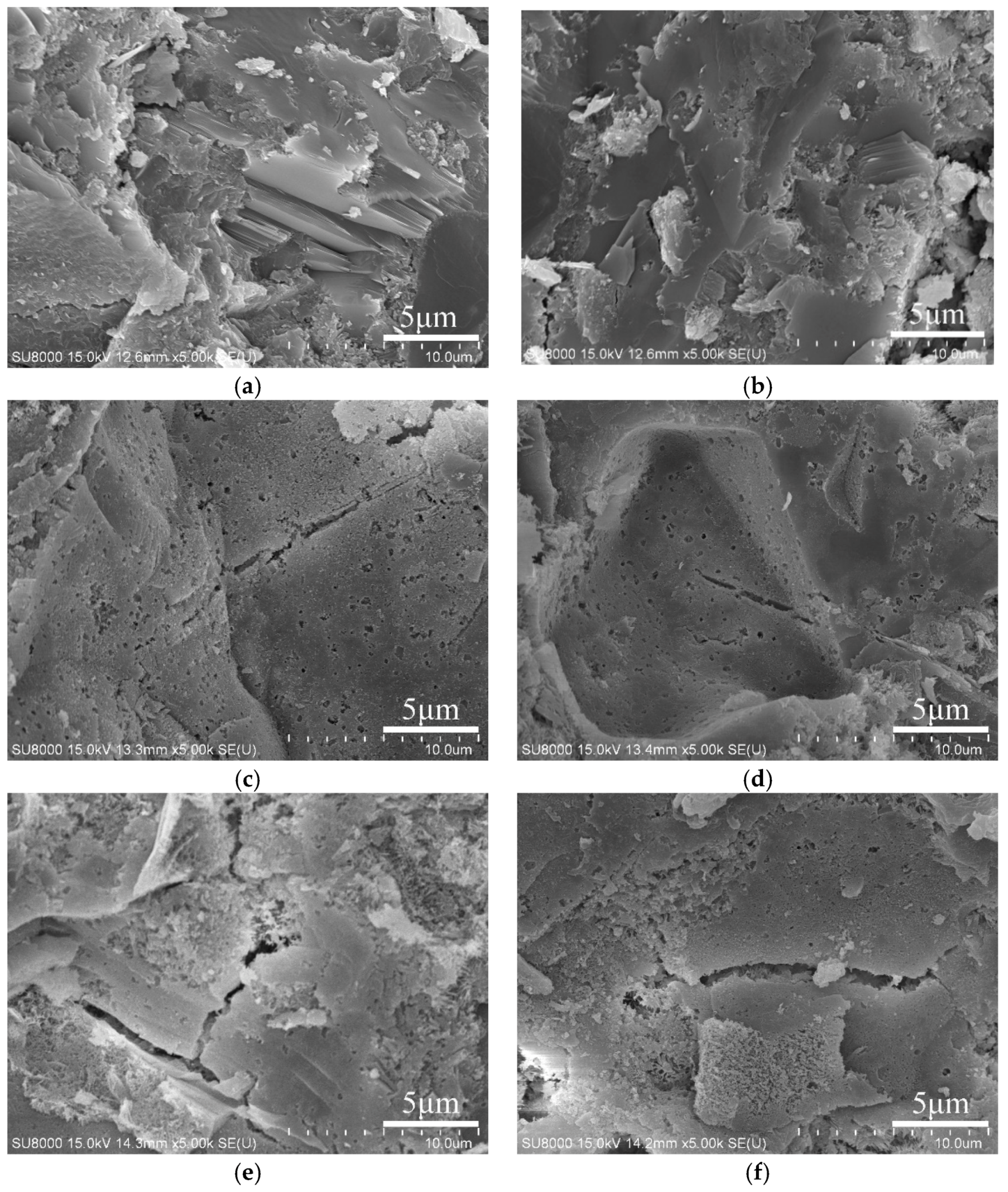
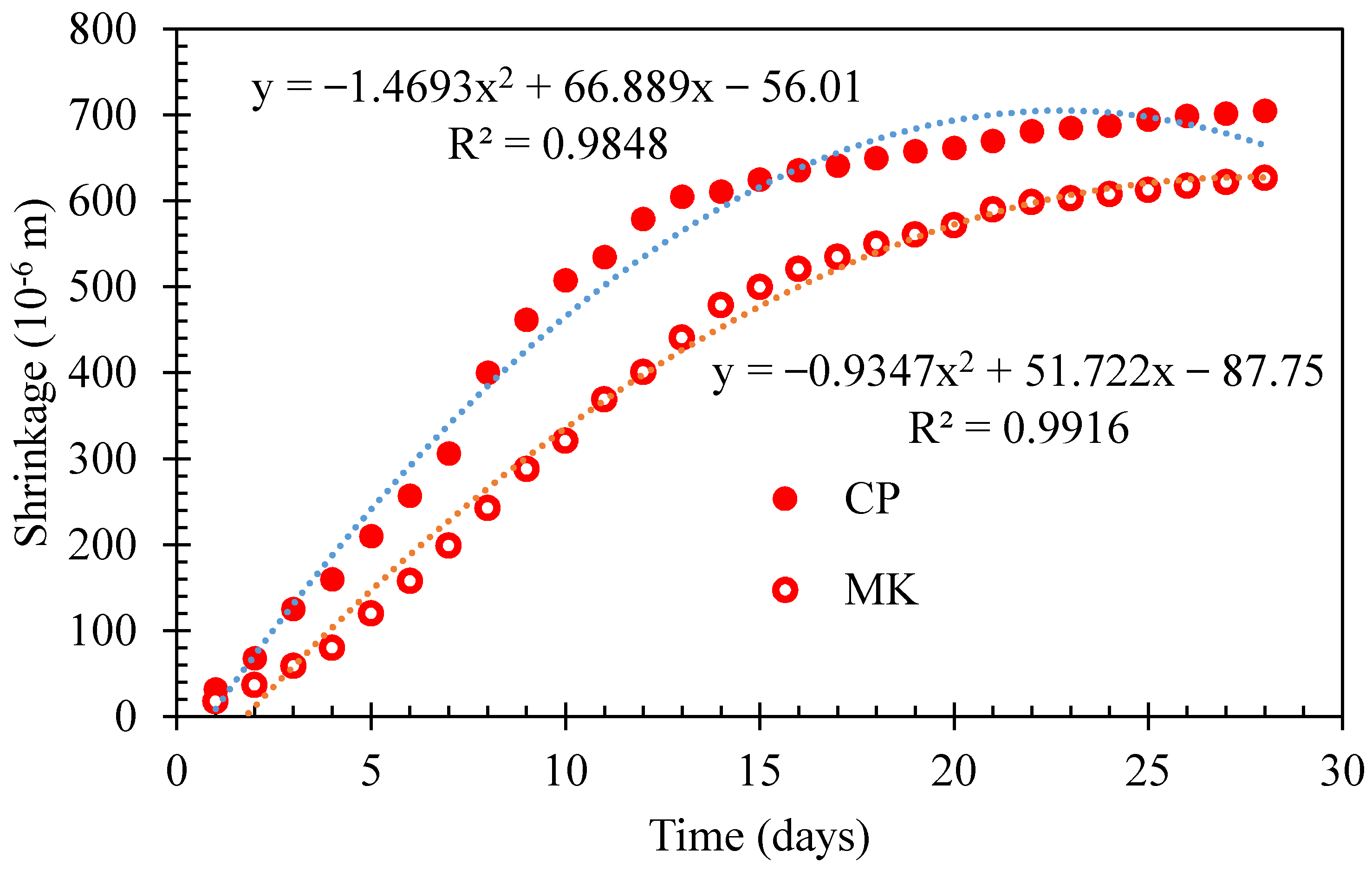
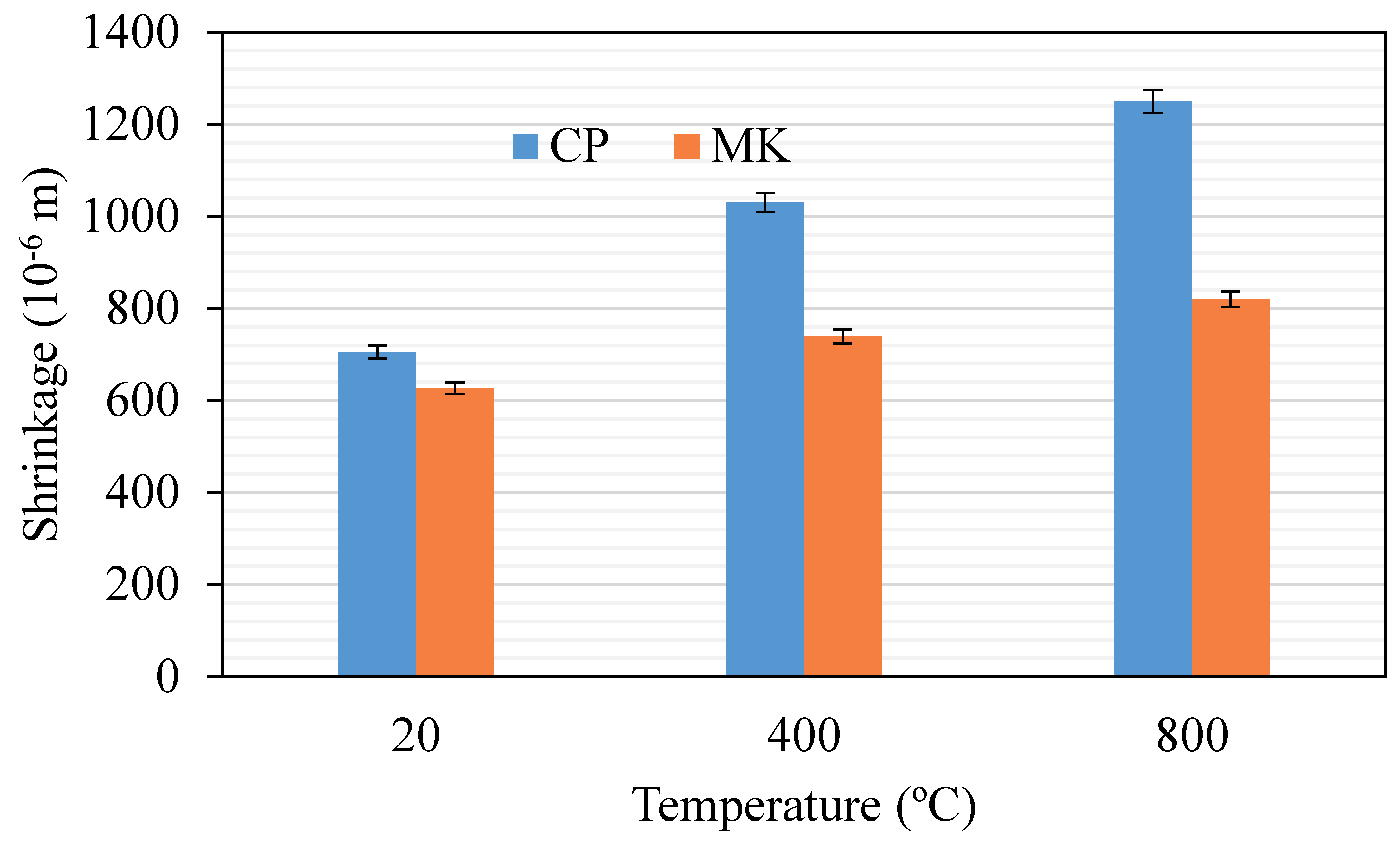
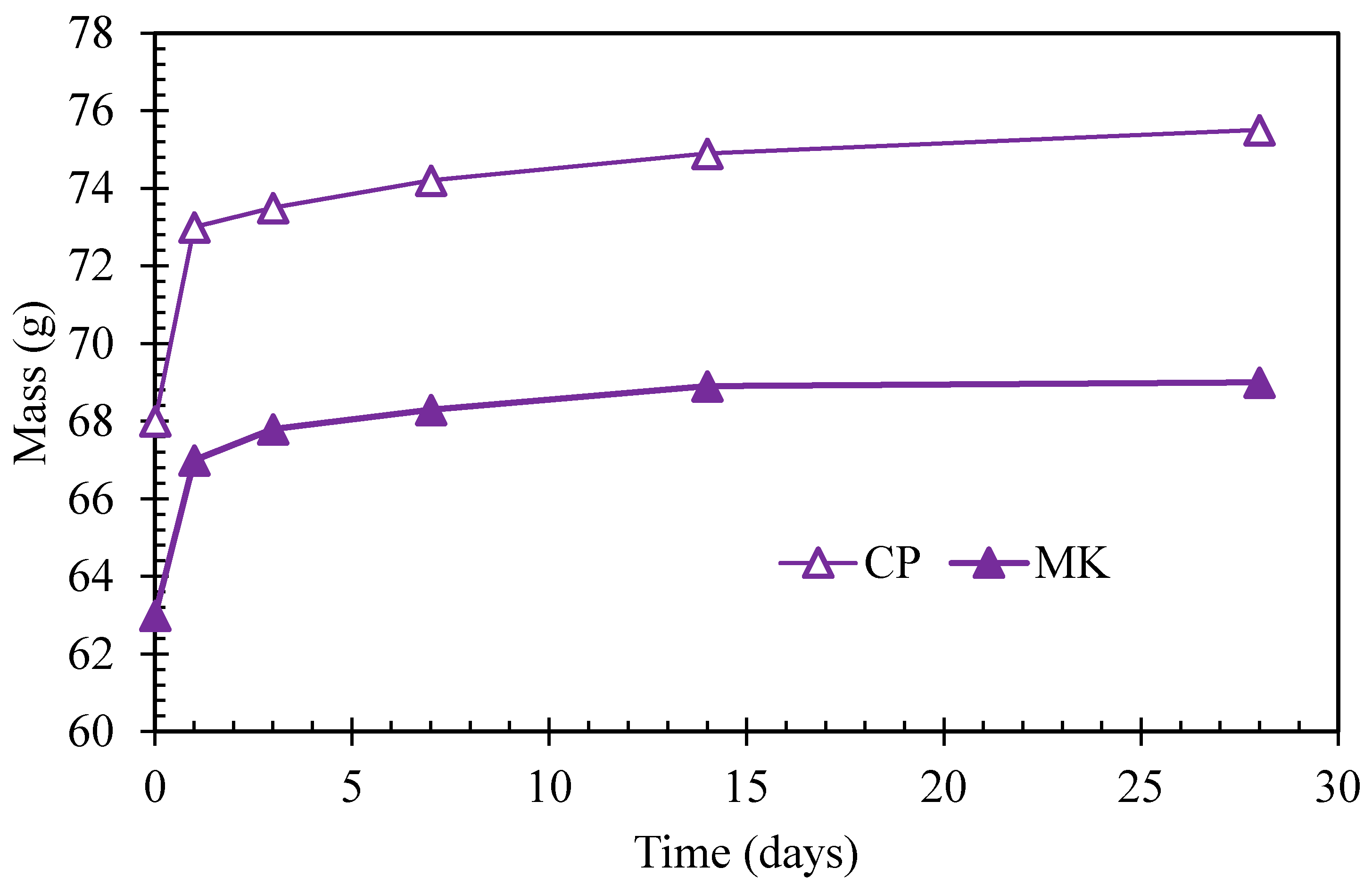
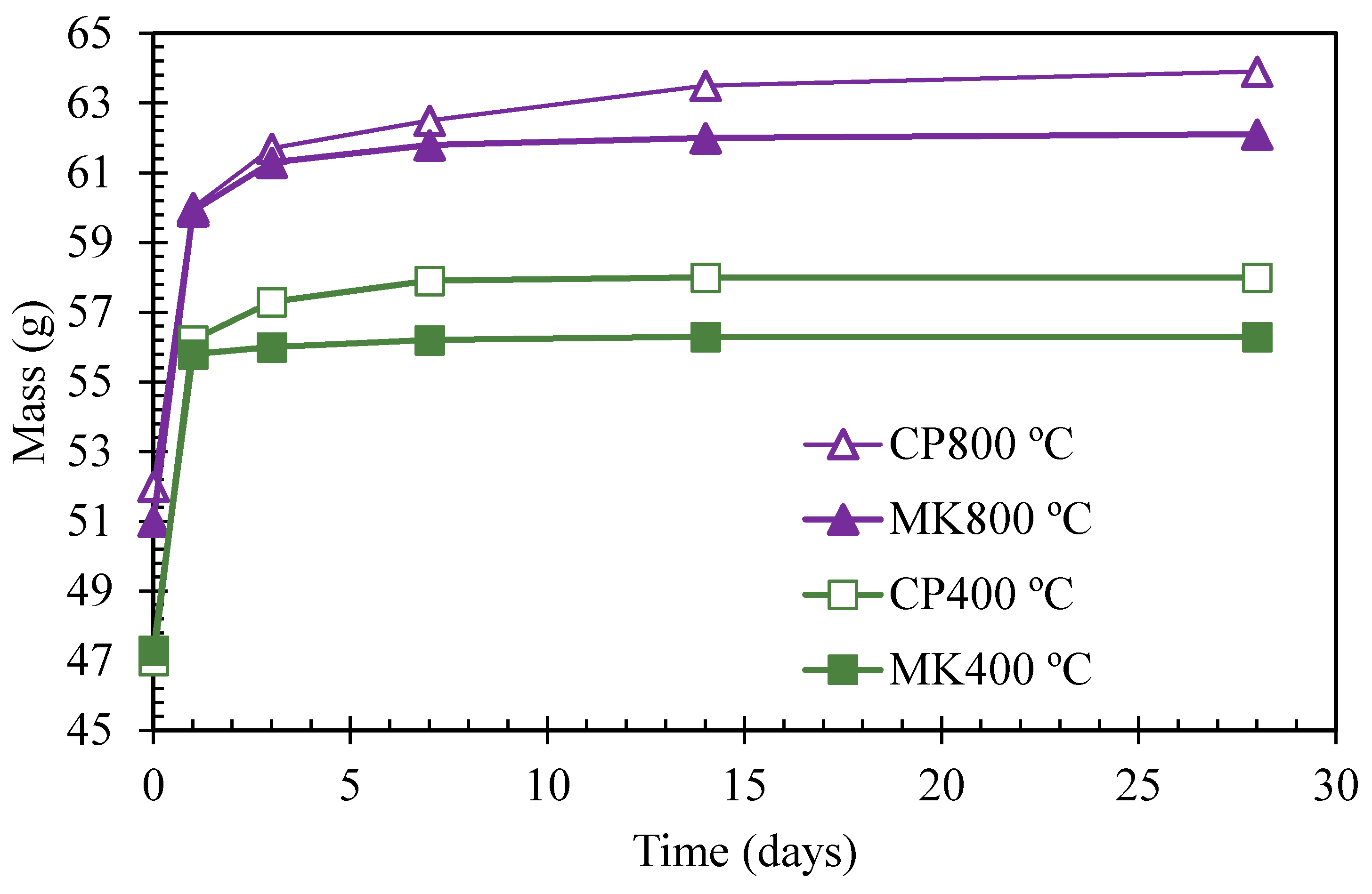
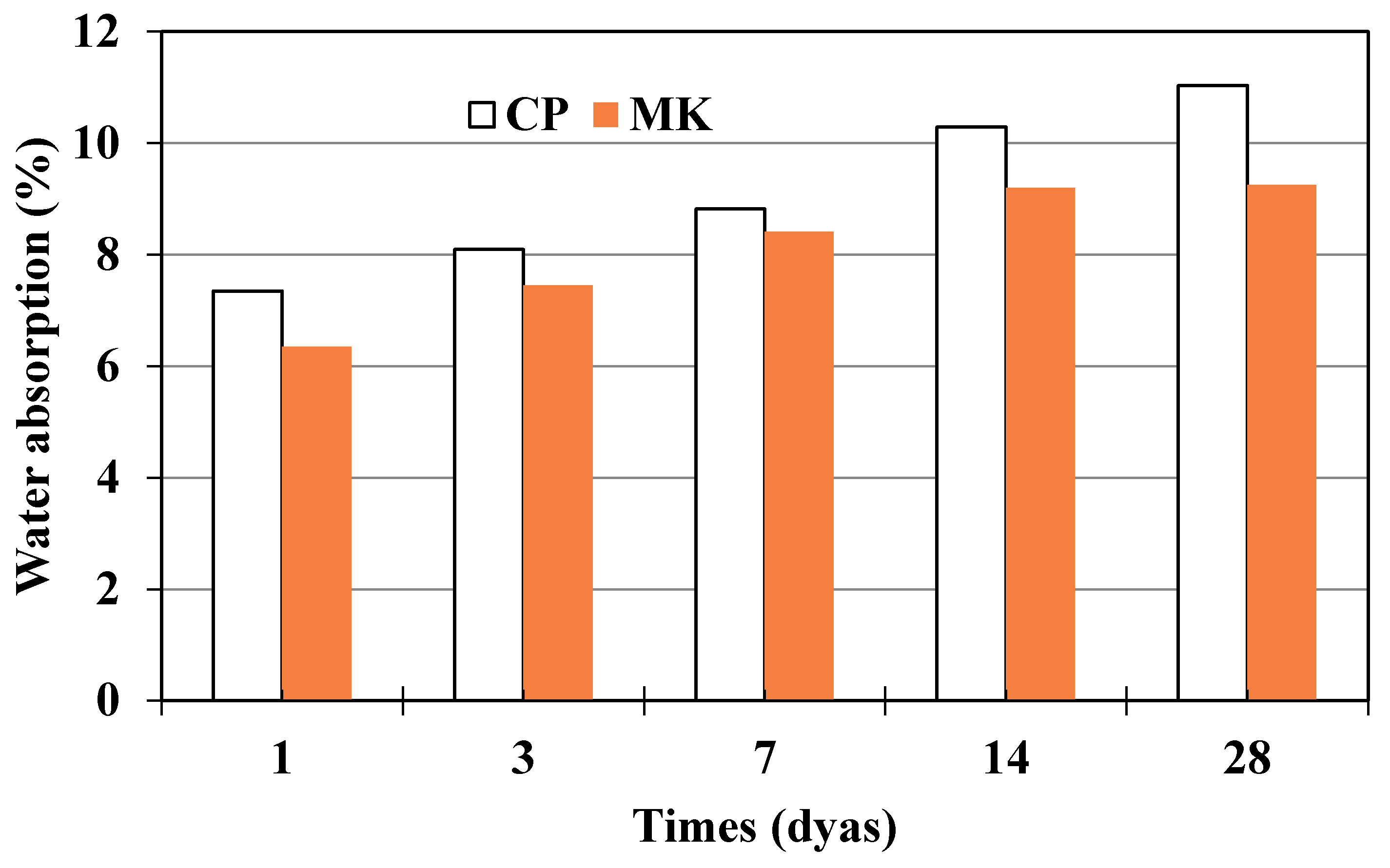
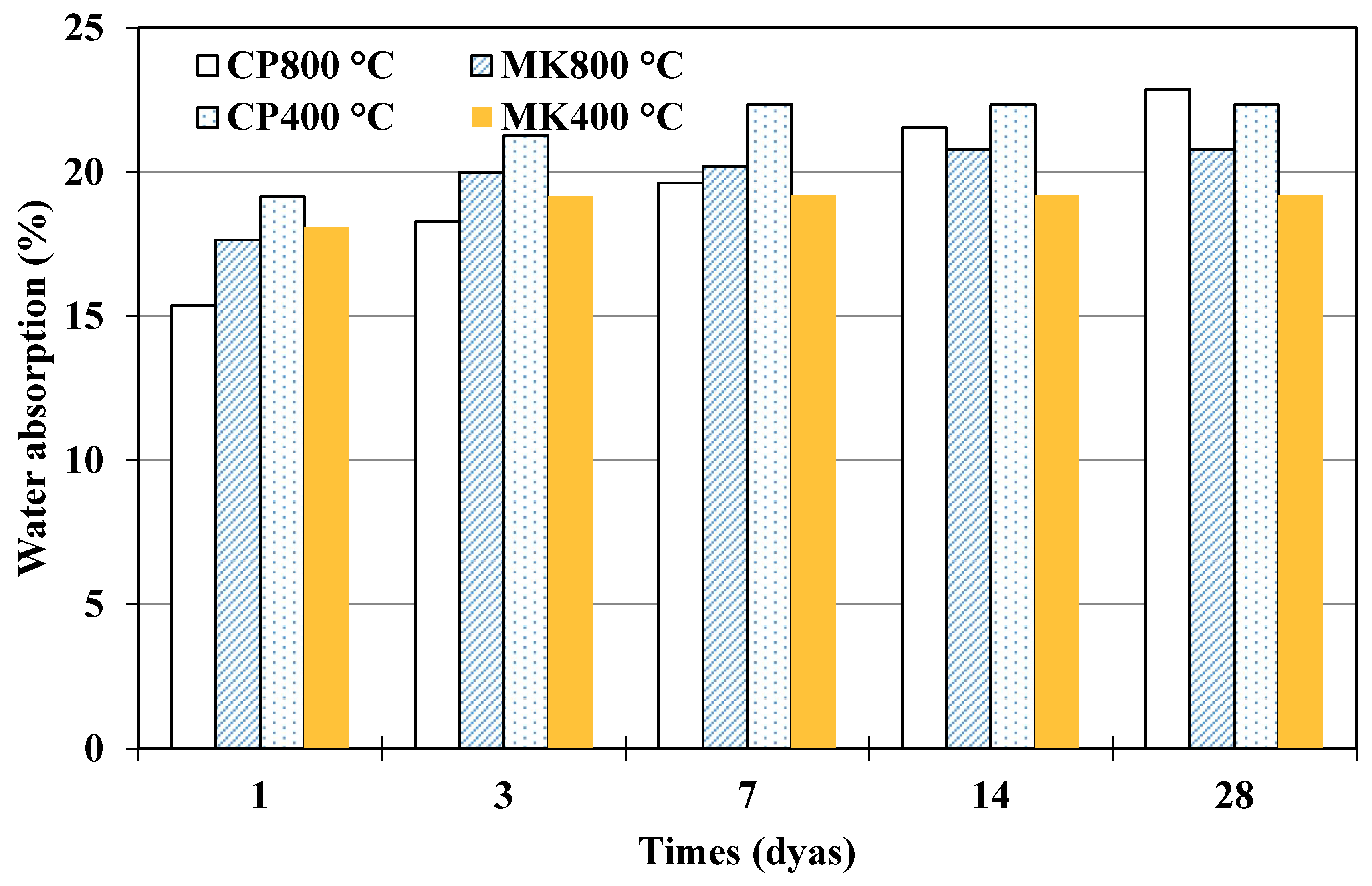
| Item | OPC | MK |
|---|---|---|
| CaO (%) | 68.30 | 0.04 |
| SiO2 (%) | 19.37 | 53.29 |
| Al2O3 (%) | 3.92 | 43.11 |
| MgO (%) | 1.61 | 0.22 |
| Fe2O3 (%) | 3.69 | 0.68 |
| K2O (%) | 0.59 | 0.42 |
| Na2O (%) | 0.13 | 0.44 |
| SO3 (%) | 0.81 | 0.11 |
| TiO2 (%) | - | 0.41 |
| P2O5 (%) | - | 0.35 |
| Loss of ignition (%) | 1.09 | 0.90 |
| Specific gravity (kg/m3) | 3110 | 2580 |
| Specific surface (m2/kg) | 369 | 12000 |
| Setting Time (min) | Flexural Strength (MPa) | Compressive Strength (MPa) | |||
|---|---|---|---|---|---|
| Initial | Final | 3 days | 28 days | 3 days | 28 days |
| 170 | 220 | 5.4 | 8.4 | 25.4 | 57.4 |
| Specimens Code | Cement (g) | Metakaolin (g) | Water (g) | Superplasticizer (g) |
|---|---|---|---|---|
| CP | 1000 | 0 | 400 | 10 |
| MK | 900 | 100 | 400 | 10 |
© 2019 by the authors. Licensee MDPI, Basel, Switzerland. This article is an open access article distributed under the terms and conditions of the Creative Commons Attribution (CC BY) license (http://creativecommons.org/licenses/by/4.0/).
Share and Cite
Wang, W.; Liu, X.; Guo, L.; Duan, P. Evaluation of Properties and Microstructure of Cement Paste Blended with Metakaolin Subjected to High Temperatures. Materials 2019, 12, 941. https://doi.org/10.3390/ma12060941
Wang W, Liu X, Guo L, Duan P. Evaluation of Properties and Microstructure of Cement Paste Blended with Metakaolin Subjected to High Temperatures. Materials. 2019; 12(6):941. https://doi.org/10.3390/ma12060941
Chicago/Turabian StyleWang, Wenqiang, Xinhao Liu, Liang Guo, and Ping Duan. 2019. "Evaluation of Properties and Microstructure of Cement Paste Blended with Metakaolin Subjected to High Temperatures" Materials 12, no. 6: 941. https://doi.org/10.3390/ma12060941
APA StyleWang, W., Liu, X., Guo, L., & Duan, P. (2019). Evaluation of Properties and Microstructure of Cement Paste Blended with Metakaolin Subjected to High Temperatures. Materials, 12(6), 941. https://doi.org/10.3390/ma12060941






